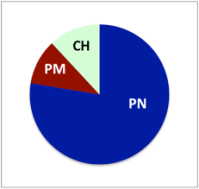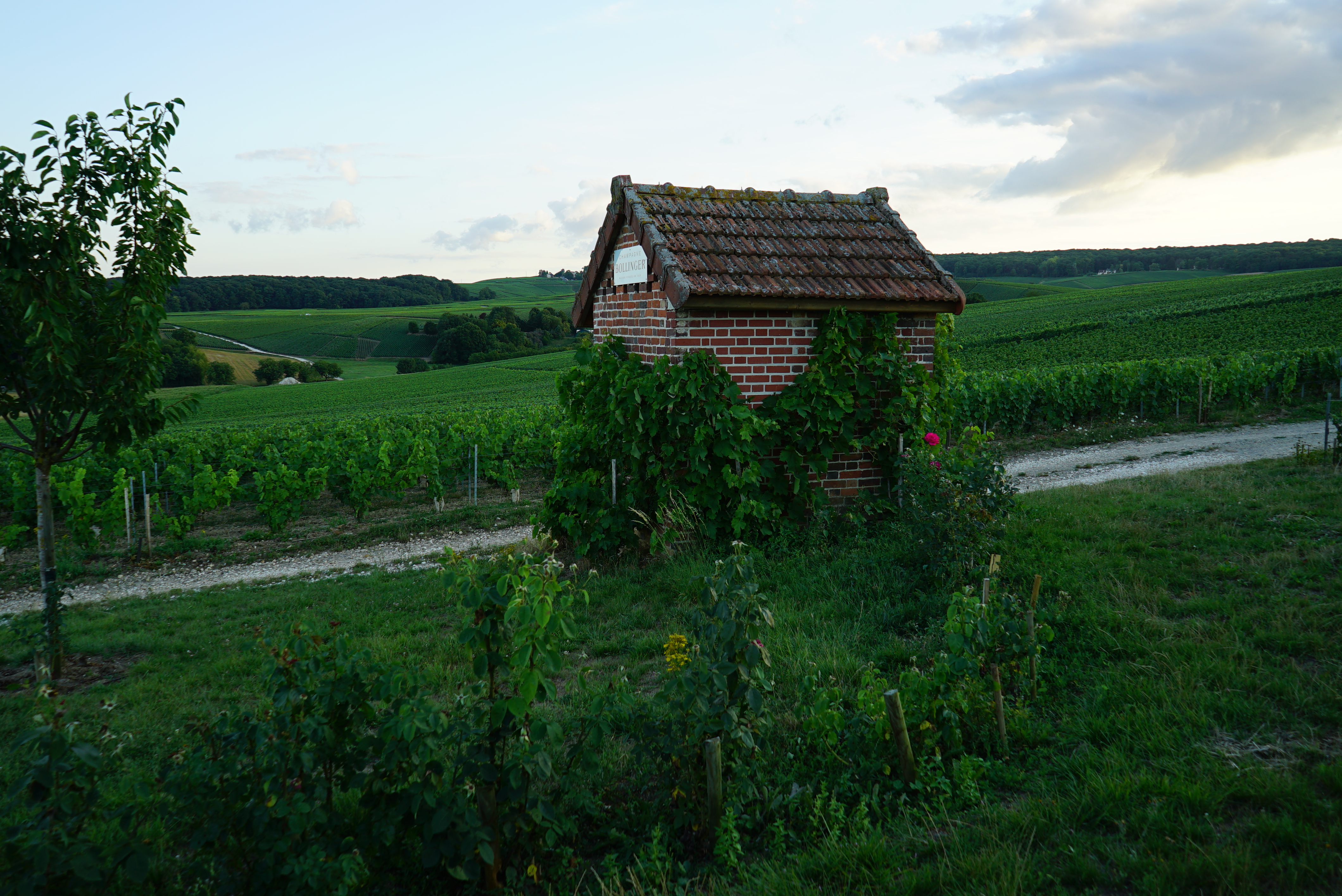 Key facts
Key facts
Located in subregion/area: Vallée de la Marne / Grande Vallée de la Marne
Vineyards and grape varieties: 237.3 hectares (586.4 acres), of which 77% Pinot Noir, 12% Chardonnay, 10% Pinot Meunier, and 0.4% other.
Classification: Premier cru (93%)
Noted for: Pinot Noir from south-facing slopes.
Maps

The map is linked from Wikimedia Commons, and the geographical information originates from OpenStreetMap. The dotted white area corresponds to the vineyards, light yellow indicates other open terrain, green is forest and orange indicates built-up areas.
Google Maps view with the villages in the Grande Vallée de la Marne highlighted. The grand cru village is in green, and the premier cru villages are in yellow.
Clicking on a village opens a field to the left with a link to the village profile.
Neighbouring villages
West: Mutigny (premier cru)
Northnorthwest: Germaine (considered part of Grande Montagne de Reims)
Northnortheast: Fontaine-sur-Aÿ (considered part of Grande Montagne de Reims)
Southeast: Bisseuil (premier cru)
South: Mareuil-sur-Aÿ (premier cru)
The village
The town hall (mairie) of Avenay-Val-d’Or. The picture is linked from Wikimedia Commons (photo October Ends, 2013).
Avenay-Val-d’Or is located in the slope above Mareuil-sur-Aÿ, and the railroad from Aÿ runs through the village and further up the hill. The village is often called Avenay, without the Val-d’Or part.
The Avenay-Val-d’Or commune covers 1249 hectares and counts 988 inhabitants (as of 2015), known as Avenaysiens and Avenaysiennes.
Avenay is a much less known village than its neighbours to the south and southwest. Therefore, they have added a further part to an old Mareuil saying: “Aÿ le nom, Mareuil le bon, Avenay passe avant”, where the final part means “(but) Avenay comes before”. This is not just an expression of the type of local patriotism found in most wine-growing villages, because Avenay was apparently a well-known village in the days when Champagne produced still wines. Among others, the Avenay wines were praised by the French 17th century libertine and hedonist Charles de Saint-Évremond, who fled to England in 1661 to avoid being jailed in the Bastille.

Vineyards between Avenay-Val-d’Or and Mutigny, as well as a small vineyard hut belonging to Bollinger. Picture linked from Wikimedia Commons (photo G.Garitan, 2017).
Vineyards
The vineyards in Avenay-Val-d’Or to a large part consist of south-facing slopes, but uneven features in the landscape means that there are also other directions and more flat vineyard. The vineyards are dominated by Pinot Noir.
The current vineyard surface in the Avenay-Val-d’Or commune is 237.3 ha (586.4 acres). There are 183.7 ha Pinot Noir (77.4%), 28.0 ha Chardonnay (11.8%), 24.6 ha Pinot Meunier (10.4%), and 1.0 ha others (0.4%). Current information from CIVC as of 2018, refers to the situation a few years earlier. In 1997, the vineyard surface was 233 ha. There are 341 vineyard owners (exploitants) in the commune.
Champagne houses that use vineyards in this village include Bollinger, Henriot, Moët & Chandon, Mumm, Philipponnat, and Veuve Clicqout.
Single vineyard sites
Single vineyard sites in Avenay-Val-d’Or includes these, among others:
- L’Ail Noé, a south- and east-facing site with a mild slope in the westnorthwestern part of the commune, with one corner located on the border to Mutigny. John Charles Ricciuti has a plot in this site.
- Le Champ Hérard, a south-facing site with a mild slope westnorthwest of the village, on the border to Mutigny. William Saintot has Pinot Noir in this site.
- La Côte de Chignon, a south-facing site northwest of the village. Borders in the west to La Côte des Perches. William Saintot has Pinot Noir in this site that is used for their rosé.
- La Côte des Perches, a south-facing site westnorthwest of the village. Borders in the east to La Côte de Chignon. John Charles Ricciuti has a plot in this site.
- Les Panthenay, a south-facing site with a mild slope in the northwestern part of the commune, on the border to Mutigny. John Charles Ricciuti has a plot in this site.
- Prôle, a rather flat site northwest of the village. William Saintot has Chardonnay in this site.
- Sorange-Ouest, a flat site south of the village, between the D201 and D271 roads, on the border to Mareuil-sur-Aÿ. John Charles Ricciuti has a plot in this site.
Avenay-Val-d’Or with surrounding vineyards and other agricultural lands, as seen from Mutigny. Picture linked from Wikimedia Commons (photo October Ends, 2013).
Champagne producers
Larger Champagne houses, members of Union des Maisons de Champagne
No major Champagne houses are located in Avenay-Val-d’Or, but Mumm Perrier-Jouët Vignobles et Recherches has a facility in the village.
Other Champagne houses/négociants
The producer status NM = négociant-manipulant means that purchased grapes can be included in the Champagnes. NM producers can be anything from small producers that supplement their own grapes with some that they buy in, to large Champagne houses that primarily rely on purchased grapes.
- Pierre Morlet (NM, French website), has about 16 ha of vineyards in Avenay-Val-d’Or, Aÿ, Bisseuil, and Mutigny with 76% Pinot Noir and 24% Chardonnay. The range includes a vintage Champagne with varying composition.
Champagne growers
Producer status is indicated where known: RM = récoltant-manipulant, or grower-producers. RC = récoltant-coopérateur, growers that are cooperative members but sell Champagnes under their own name.
- Jean-Pierre Anceau (RC)
- Augustin (RM, Facebook page), formerly Augustin & Fils, a biodynamical producer with 9 ha of vineyards in Avenay-Val-d’Or (6 ha) and Vertus (3 ha). Run by Marc Augustin who uses organic cultivation since 2012, biodynamical cultivation since 2013, and is Demeter certified since 2015. The cuvées are numbered using Roman numerals and the labels include references to the four elements of alchemy. Only a part of the harvest is used for their own Champagnes, 10 000 bottles per year, and the rest is sold to Champagne houses that have biodynamic cuvées in their range.
- Jean Augustin (RM) which has about 10 ha of vineyards.
- Hubert Billiard (RM?), member of Vignerons Indépendants, has 4.3 ha of vineyards in Mutigny, Avenay-Val-d’Or och Ambonnay with 50% Pinot Noir, 40% Pinot Meunier, and 10% Chardonnay. The top cuvée is called Le Gaulois, is composed of 60% Pinot Noir and 40% Chardonnay, and is partly oak barrel-vinified. More information here.
- P. Alain Billiard (RM), also Pierre-Alain Billiard
- Canavesio Gabriel
- Conreur (RC)
- Crucifix Pere & Fils (RC, Facebook page), a member of the “oak barrel organisation” Cercle des Créateurs de Champagnes Confidentiels. Before 2005 the name was Jean-Jacques Crucifix. The top cuvée is called Signature, is composed of 80% Chardonnay and 20% Pinot Noir, and is oak barrel-vinified.
- Jean Gabriel (RC)
- R. Gabriel-Pagin Fils (RM), a member of Vignerons Indépendants. Has 9.5 ha of vineyards in Avenay-Val-d’Or, Mutigny, Avize, and Cramant with 80% Pinot Noir, 18% Chardonnay, and 2% Pinot Meunier. The vintage Champagne is called Cuvée Roger Gabriel is a blanc de blancs from 100% Chardonnay (refers to the 2006 vintage).
- Laurent-Gabriel (RM), a member of Vignerons Indépendants. Has about 3 ha of vineyards, including in Avenay-Val-d’Or and Avize. The vintage Champagne is composed of 80% Pinot Noir and 20% Chardonnay (refers to the 2000 and 2002 vintages).
- Husson-Thieffenat (RC)
- Lejeune-Del’Hozanne (RM, Facebook page)
- Lejeune-Del’Hozanne (RM, Facebook page), which has vineyards in Avenay-Val-d’Or, Dizy, and Mutigny. The top Champagne is called Léon and is a non-vintage 100% Pinot Noir from the vineyard site Le Léon in Dizy. Also a Léon Chardonnay is produced.
- Denis Mareigner (RC)
- Jean Marniquet (RM, Facebook page), has vineyards in Avenay-Val-d’Or, Mutigny, and Oger. The vintage Champagne is composed of 60% Chardonnay and 40% Pinot Noir, and is partly oak barrel-vinified. The company name is Brice Marniquet.
- Bernard Morozoff (RC)
- Picart-Thiout (RM, Facebook page), has 6.5 ha of vineyards in Avenay-Val-d’Or, Tauxières-Mutry, and Tours-sur-Marne. The range includes a vintage Champagne composed of 100% Chardonnay (refers to the 2008 vintage), and small amounts of both white and red still wine (Coteaux Champenois).
- Poul-Justine (RM), whose range includes a vintage Champagne. There are also older bottles with an NM code that are produced by Henriot in Reims.
- Guillaume Remion (RM), whose range includes a vintage Champagne.
- Renault-Allart (RC)
- Gaston Révolte (Facebook page), has 6 ha of vineyards (5 ha in Avenay-Val-d’Or and 1 ha in Mutigny) with 90% Pinot Noir and 10% Chardonnay. The annual production is about 40 000 bottles.
- John Charles Ricciuti (RM, Facebook page), also J.C.R., and formerly Ricciuti-Révolte. Has vineyards in Avenay-Val-d’Or, Chouilly, Mareuil-sur-Aÿ, and Mutigny with 90% Pinot Noir and 10% Chardonnay. The vintage Champagne is called by JCR and is a blanc de blancs on 100% Chardonnay from old vines in Chouilly (refers to the 2011 vintage). The company name is Ricciuti-Legras.
- Yves Ruffin (RM), has 3 ha of vineyards in Avenay-Val d’Or and Tauxières-Mutry with 60% Chardonnay and 40% Pinot Noir. Certified for organic cultivation since 1971. The range includes two vintage Champagnes: Cuvée Précieuse which is composed of 75% Chardonnay and 25% Pinot Noir, and Cuvée Thierry Ruffin which is 80% Chardonnay and 20% Pinot Noir (refers to the 2006 vintage).
- Guy Saintot
- Roger Saintot
- William Saintot (RM, Facebook page), a member of Vignerons Indépendants, has 10.27 ha of vineyards with 90% Pinot Noir, 7% Chardonnay, and 3% Pinot Meunier. Annual production is 25 000 bottles. Also operates a plant nursery for vines. Séduction is a non-vintage 100% Chardonnay originating from a single vineyard site, Barmont in Bisseuil. The vintage Champagne is composed of Chardonnay from the sites Prôle and Barmont (the latter in Bisseuil) and Pinot Noir from the sites Le Champ Hérard and La Côte de Chignon. In the 2012 vintage the composition is 60% Pinot Noir and 40% Chardonnay. La Côte de Chignon is a vineyard-designated 100% Pinot Noir from a site in Avenay-Val-d’Or, which is produced as a vintage Champagne.
- Yves Saintot (RM, Facebook page), whose range includes a vintage Champagne only produced in magnum.
- Turot-Duré (RC)
- Vatel-Fouquy
Comment: it is not certain that the list is complete.
Cooperative
When bottles are sold directly by a cooperative the producer status is given as CM = coopérative de manipulation, as opposed to RC when sold by a cooperative member under their own name.
- Coopérative Vinicole le Val-d’Or, a cooperative in Avenay-Val-d’Or founded in 1948. Since 2017 they are member of the major cooperative Union Champagne in Avize, which are behind e.g. the brand De Saint Gall. The cooperative has 108 members with a total of 58 ha (information from 2017).
The church in Avenay-Val-d’Or, Église Saint-Trésain. Picture linked from Wikimedia Commons (photo October Ends, 2013).
Links
- Wikipedia about this village in English, in French.
- Website of the commune Avenay-Val-d’Or.
- UMC’s village profile of Avenay-Val-d’Or.
- Vineyard map of Avenay-Val-d’Or på weinlagen-info.de.
- The Swedish version of this post.
© Tomas Eriksson 2014-2018, last updated 2018-12-02

Pingback: All villages in Champagne in alphabetical order – champagneclub